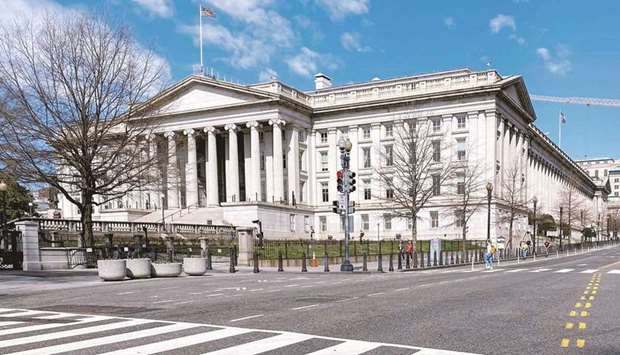The US Treasury kept its quarterly auction of long-term debt, planned for next week, at a record size to help fund the government’s continuing wave of stimulus spending.
It’s the first time in more than a year that the so-called quarterly refunding total hasn’t risen, suggesting that financing needs have peaked. The department, in a statement on Wednesday, offered no major changes in its debt-issuance strategy, and said it will sell $126bn of long-term securities at auctions next week.
The Treasury highlighted that it may face challenges if Congress fails to suspend or increase the federal debt limit when the current suspension runs out at the end of July.
On previous occasions, the Treasury has used various measures to keep servicing federal debt outstanding while lawmakers and the White House wrangled over raising the ceiling. But this year could bring added strains, the department said.
“In light of the substantial Covid-related uncertainty about receipts and outlays in the coming months, it is very difficult to predict how long extraordinary measures might last,” the Treasury statement said. “Treasury is evaluating a range of potential scenarios, including some in which extraordinary measures could be exhausted much more quickly than in prior debt limit episodes.”
A still-large cash pile and the prior ramping up in auctions means the Treasury doesn’t need to further boost its debt issuance even after the enactment of the $1.9tn March pandemic-relief bill. The Treasury accumulated a record cash balance of $1.8tn at one point last year.
Big decisions on debt issuance loom later this year, with the government’s borrowing needs set to shrink rapidly as Covid-19 stimulus spending ebbs and the economic recovery sets in. While President Joe Biden is calling for $4tn in further initiatives, those are aimed over several years, with tax hikes planned to help pay for them.
Treasury Secretary Janet Yellen and her team will need to decide whether and how quickly to shrink sales of so-called coupon-bearing debt – securities that pay interest. Her predecessor Steven Mnuchin actively sought to lengthen the average maturity of Treasuries to take advantage of historically low longer-term rates.
The majority of Wall Street bond dealers had predicted the Treasury would make no changes to nominal coupon-bearing debt auctions. Several forecast a reductions beginning as early as August. Sales of notes and bonds ranging from seven to 30 years have doubled in size thanks to Covid-19 spending, HSBC Holdings Plc estimates show. “Even if Congress passes a large-scale infrastructure package which is funded over a five to 10-year horizon, Treasury’s current auction schedule leaves it more than adequately financed in coming years,” Jay Barry, a strategist at JPMorgan Chase & Co wrote in a note last week. “Treasury should begin making cuts to its auction sizes in relatively short order.”
If coupon-bearing auction sizes aren’t trimmed in coming quarters, it would likely result in the Treasury needing to cut bill sales to a degree that pushes their share of total below the 15% to 20% range the Treasury Borrowing Advisory Committee has previously advised, Barry said. T-bills made up around 22% of marketable Treasuries at the end of March. The Treasury said Wednesday it “anticipates no changes to nominal coupon and floating-rate note auction sizes over the upcoming May to July 2021 quarter. Treasury plans to address any seasonal or unexpected variations in borrowing needs over the next quarter through changes in regular bill auction sizes and/or cash management bills.”
The Treasury has this year been slowly reducing its use of bill sales, after relying on them heavily at the start of the pandemic to fund pandemic relief spending and build up a record stockpile of cash to offer extra flexibility amid the crisis.
Between now and the end of July, the Treasury estimated a reduction in bills outstanding of about $150bn – approximately one-third of the decline in bill supply that has already occurred since the February 2021 refunding.

The US Treasury Department building in Washington. The US Treasury kept its quarterly auction of long-term debt, planned for next week, at a record size to help fund the government’s continuing wave of stimulus spending.


